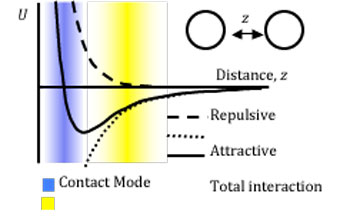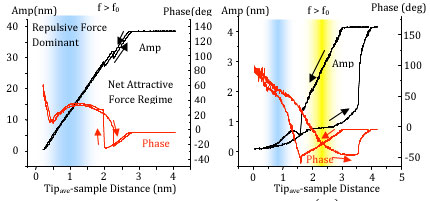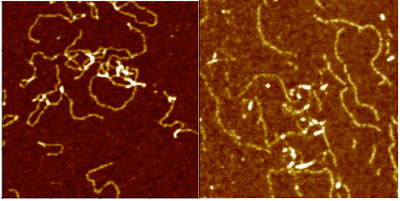| Posted: Mar 09, 2010 | |
Non-Disruptive Imaging of Soft Biological Samples Using True Non-Contact AFM |
|
| (Nanowerk Spotlight – Application Note) Imaging soft biological samples in liquid with Atomic Force Microscope (AFM) has long stood as a very challenging task. Until recently, most of the works in this field has been carried out in tapping mode AFM, during which the cantilever driven by a piezoelectric actuator vibrates in the vicinity of the cantilever’s resonance frequency, and briefly touches the sample surface at the bottom of each vibration cycle, resulting in a decrease of its oscillation amplitude. By keeping such amplitude at a preset value (setpoint) using feedback control, a topographic image of the sample surface is obtained. | |
| However, stable, high-resolution imaging of very fragile and sensitive biological samples such as live cells or individual proteins is not trivial in tapping mode due to potential sample distortion or even damage during the brief contact between the AFM tip and sample surface at the end of each oscillation cycle. The relatively large tip-sample interaction force during the impact would often deform the sample surface around the contact point, thus limit the highest resolution obtainable in this mode, rendering tasks such as resolving individual proteins or nucleic acids almost impossible. | |
| Furthermore, in tapping mode AFM imaging, the tip-sample contact time is largely dependent on the mechanical properties of the sample. For soft biological samples with Young’s modulus in the range of 1 kPa ∼100 MPa, the tip-sample contact time could take between 20% and 90% time of the entire oscillation cycle. Such long contact time would not only increase the chance of unwanted sample damage, but also induce possible tip contamination by adhesive organic molecules commonly present on such sample surfaces. | |
 |
|
| Figure 1: Inter-Atomic force | |
| The XE-series AFM with Crosstalk Elimination (XE) and high force Z-scanner has successfully solved the aforementioned problems by operating in the “True Non-Contact Mode” instead of tapping (intermittent contact) mode. Previous studies have shown that AFMs utilizing amplitude modulation feedback mechanisms could operate in two different interaction regimes, attractive and repulsive.1, 2, 3 | |
| In the attractive interaction regime, a net attractive force between the tip and the sample dominates the amplitude reduction of the tip oscillation in the absence of real tip-sample contact. In the repulsive interaction regime, a net repulsive force containing long-range attractive component and short-range repulsive component control the cantilever dynamics, resulting in inevitable tip-sample contact at each end of the cantilever oscillation cycle (Figure 1). | |
| Lacking of sophisticated and accurate control to stay in the attractive interaction regime without tip crashing onto rough sample surfaces, most AFM vendors in the market elect to operate their systems in the repulsive force regime, allowing the tip to periodically come into contact with sample surface (tapping mode AFM). With its high force z scanner actuated by patented multiple stacked piezos (typical resonant frequency ~ 10 kHz) and high performance controller electronics, the XE-series AFM are much more sensitive and responsive to the minute amplitude change caused by the smaller frequency shift in the attractive interaction regime. The fast response of the low-inertia z scanner allows precise tracking of the AFM tip movement along sample surface topography, therefore allows the tip to retract promptly when encountered with sharply-rising sample features, and stay in the attractive force regime without crashing onto the sample surface. | |
 |
|
| Figure 2: Amplitude-Distance curves for different free amplitude (f0 is the resonance frequency of cantilever, and f is the operating driving frequency) | |
| Moreover, compared to tapping mode AFMs in the market, the XE-series AFM operates at much smaller cantilever oscillation amplitude in its True Non-Contact mode. From the amplitude vs. distance plots shown in Figure 2, one can easily see that for a tip oscillating in a large free air amplitude (40 nm here shown in Figure 2a, which is in the typical order of magnitude used for tapping mode AFMs in the market), only within a small portion of the entire curve (< top 25%) lies in the attractive force regime. Hence, under such conditions, it is extremely difficult to precisely control the tip to operate only in the attractive force region. | |
| On the other hand, with a smaller free air amplitude (4 nm here shown in Figure 2b, which is the typical order of magnitude used for the XE-series AFMs operating in the True Non-Contact mode), most of the curve falls under the attractive interaction regime, making it relatively easy for the XE-series AFM to operate in the True Non-Contact imaging mode. It is worth to point out that when such small free-air amplitude is used, it requires extremely precise control mechanism as well as fast feedback response to track the change of amplitude due to the tip-sample interactions. In the XE-series AFMs, such fast servo in Z-scan feedback performance is ensured by the combination of high force z scanner and high speed control electronics. | |
| True Non-Contact AFM vs. Tapping AFM for Imaging Soft Biological Samples | |
 |
|
| Figure 3: AFM topography images of single strand G4 DNA molecules (Scan Size: 1x1µm) | |
| Compared to the tapping mode utilized by most AFMs in the market, the True Non-Contact mode of the XE-series of AFM ensures minimal sample degradation due to the tip-sample interaction force for soft biological sample imaging, and virtually no disturbance on living samples such as cells from its original state. Since the tip never comes into contact with sample surface, tip contamination from adhesive molecules existing on such surfaces can be largely avoided, and therefore preserve optimal resolution throughout imaging. When scanning biomolecular samples with nanometer dimensions such as proteins, the True Non-Contact mode with its ability to preserve tip sharpness, and its minimal interaction force would allow ultimate resolution of individual molecules, even their structural segments. | |
| Non-Contact Mode and Q-control Method for Liquid Imaging | |
| In conventional tapping mode AFM, the need to use an effective Q-control method during liquid imaging of soft biological samples arises from the fact that Quality (Q) factor of the cantilever resonance peak decreases drastically in liquid due to the viscosity and inertia resistance of the liquid, which in turn causes largely decreased force sensitivity, even unstable cantilever oscillation. More importantly, in a low Q environment, under the same amplitude set point, the interaction force between the AFM tip and the sample can be much larger compared to that in a high Q environment. | |
| Such excessive tip-sample interaction force could cause serious damage on soft biological samples such as living cells even when the set point is chosen to be fairly close to the free air amplitude of the cantilever. Hence, various techniques have been invented to enhance the driving single of cantilever oscillation by adding a modulated cantilever oscillation signal which is phase-shifted by π/2 and amplified by the gain factor successively. Using the method, the effective damping constant can be easily decreased by increasing the gain factor, resulting in a much improved Q-factor. However, such artificial control of the Q-factor not only increases the signal level, but is also apt to amplify any parasitic oscillation signals and noise by the same gain factor. Therefore, the signal-to-noise ratio, which is predominantly determined by thermal fluctuation, cannot be improved by this method. | |
| Since the True Non-Contact mode used by the XE-series AFM is operated on the attractive regime of tip-sample interaction, and at a comparably much smaller vibration amplitude, the tip-sample interaction force are minimal under normal imaging conditions, rendering the aforementioned consideration unnecessary. However, it is true that when the cantilever excitation is carried out in liquid, its vibration spectrum usually contain various non-intrinsic peaks that depend strongly on the excitation mode and vibration status of the cantilever, making the identification of true cantilever resonance peak extremely difficult. Aware of this problem, the XE-Series of AFM has incorporated the Q-control component in order to enhance the resonance spectrum in liquid, hence reduce the difficulty in the resonance peak identification process for users frequently performing liquid imaging tasks. | |
| References | |
| 1. García, R., and A. San Paulo. Attractive and repulsive tip-sample interaction regimes in tapping-mode atomic force microscopy. Phys. Rev. B. (1999) 60:4961– 4966. | |
| 2. García, R., and A. San Paulo 1999b. Amplitude curves and operating regimes in dynamic atomic force microscopy. Ultramicroscopy (2000) Feb;82(1-4):79-83. | |
| 3. Yueming Hua, Cynthia Coggins, Sung Park, Ryan Yoo, and Sang-il Park. Extended probe tip lifetime in True Non-Contact mode. Submitted to Ultramicroscopy (2009) | |
| By Park Systems | |
|
Become a Spotlight guest author! Join our large and growing group of guest contributors. Have you just published a scientific paper or have other exciting developments to share with the nanotechnology community? Here is how to publish on nanowerk.com. |
|
